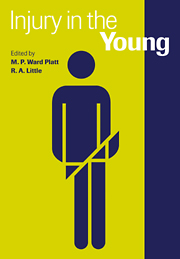Book contents
- Frontmatter
- Contents
- List of contributors
- Editors' Preface
- 1 The epidemiology of trauma involving children
- 2 Emergency room requirements for children
- 3 Child deaths in Accident and Emergency
- 4 Immediate life support
- 5 Evaluation of injury in children
- 6 Injuries of the developing brain
- 7 Wound healing in children
- 8 The lung after injury in children
- 9 Metabolic and endocrine stress responses to surgery
- 10 Head injury in children
- 11 Near drowning
- 12 The acute response to burn injury in children
- 13 Nutritional support of the severely burned child
- 14 Recovery, rehabilitation and the neuropsychological sequelae of head injury
- 15 Children's rights and child protection
- Index
12 - The acute response to burn injury in children
Published online by Cambridge University Press: 18 September 2009
- Frontmatter
- Contents
- List of contributors
- Editors' Preface
- 1 The epidemiology of trauma involving children
- 2 Emergency room requirements for children
- 3 Child deaths in Accident and Emergency
- 4 Immediate life support
- 5 Evaluation of injury in children
- 6 Injuries of the developing brain
- 7 Wound healing in children
- 8 The lung after injury in children
- 9 Metabolic and endocrine stress responses to surgery
- 10 Head injury in children
- 11 Near drowning
- 12 The acute response to burn injury in children
- 13 Nutritional support of the severely burned child
- 14 Recovery, rehabilitation and the neuropsychological sequelae of head injury
- 15 Children's rights and child protection
- Index
Summary
Introduction
Burns and scalds in infancy and childhood represent a significant proportion of all accidents (Lindblad & Terkelsen, 1990; Ryan et al., 1990; Smith & O'Neill, 1994; Enescu et al., 1994; Chapman et al., 1994). Before going to school one child in 130 will be admitted to hospital with a burn or scald (Lawrence & Wilkins, 1986).
Although the physical and emotional problems may be distressing, most children do survive their injuries. The number of children who die from burns and scalds each year is still very small. (Over a 14-year period to 1994 mortality at the Regional Paediatric Burns Unit for the North West of England, ranged from 0 to 1.8%, median 0.98%.) When burns are extensive the mortality rate rises. Complications after a burn can occur early from (for example) the inhalation of smoke and poisonous substances (Kinsella, 1988) and later on failure of one or more organs increases the mortality (Deitch, 1988). The probability of mortality can be predicted from the size and nature of the burn as well from the age of the patient (Bull, 1971). To audit the efficacy of treatment and clinical performance the predicted mortality can be compared with inpatient records of fatal cases; however this only tells us the final outcome: whether the patient recovered or died from his/her injuries. More useful would be the ability to measure illness.
- Type
- Chapter
- Information
- Injury in the Young , pp. 211 - 235Publisher: Cambridge University PressPrint publication year: 1998
- 2
- Cited by



